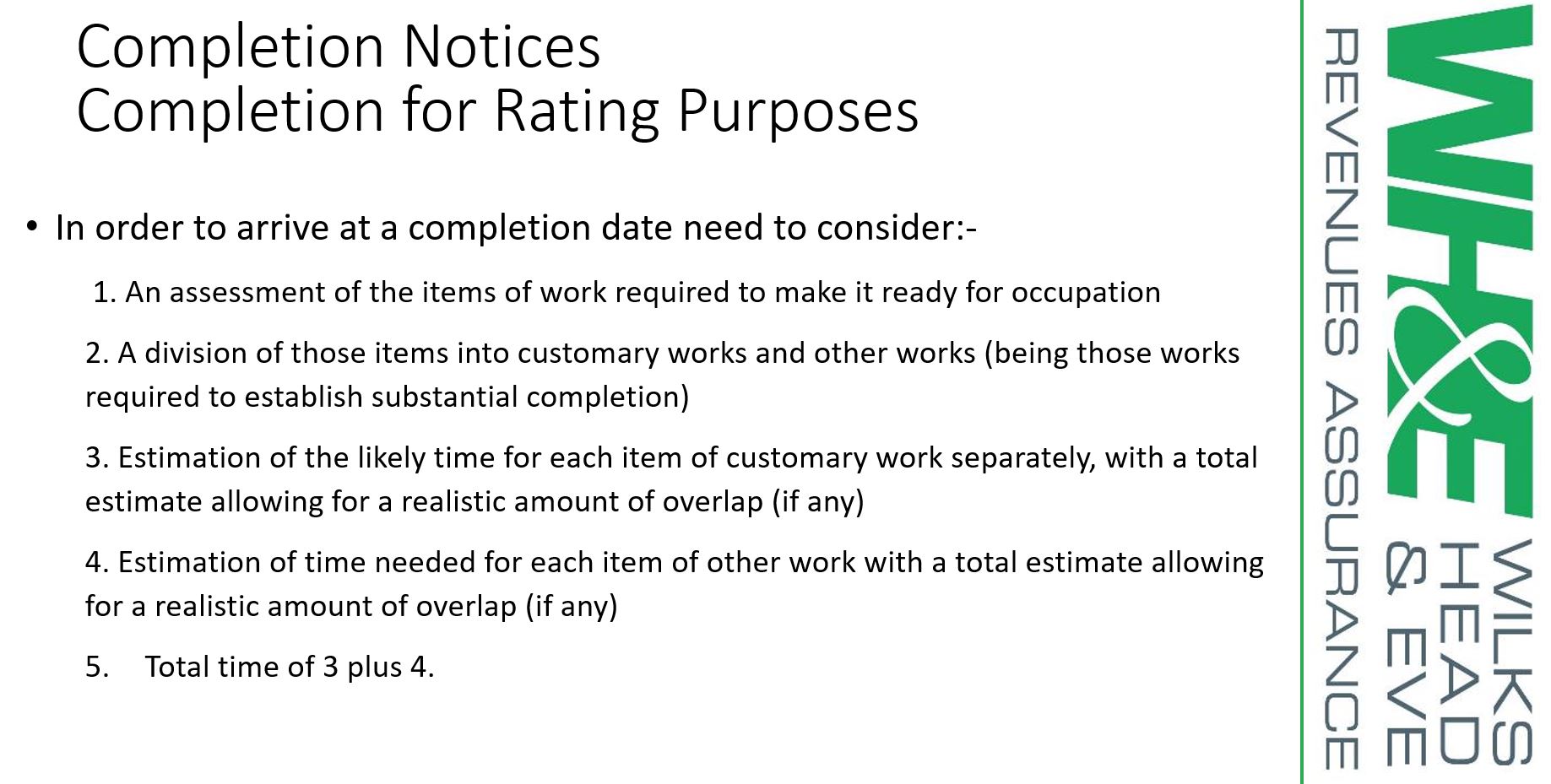 Following on from our first blog on tips for issuing completion notices, Stephanie O’Neill a Partner at Wilks Head & Eve gives some practical guidance on when completion notices should be issued and factors to consider.
Following on from our first blog on tips for issuing completion notices, Stephanie O’Neill a Partner at Wilks Head & Eve gives some practical guidance on when completion notices should be issued and factors to consider.
One size does not fit all
First and foremost each case needs to be considered on its own merits, some are more complex than others. The key is to trigger the completion notice at the right time and to do that you need to have an understanding of the project being undertaken on site. So knowing what stage the build is at is key to knowing when to serve the completion notice.
This can be achieved by relying on information from people on the ground such as Site Managers, or the Owner themselves, in some cases this information doesn’t get passed up quickly enough and from a Billing Authority perspective you want the liability to start from when it absolutely first can. Getting out on the ground and inspecting the property yourself ensures the owner understands that they are not going to be able to push the date out.
‘Shell’ and ‘fit’ out from a building perspective
Whilst a structure may appear complete from the outside the reality is it might not be in a state to be deemed complete for completion notice purposes so inspecting internally and externally and having an understanding of the works that are remaining to be done is really important.
The Shell covers the essentials that can be installed before space is tailored to the needs of the occupier. It generally comprises the structure, cladding, base plant and completed common areas and external works.
Typical communal areas include receptions, lobbies, lifts, stairwells and toilets and once this phase is complete you are left with the bare bones or the basic shell.
Category A vs Category B fit out
A Category A fit out is generally carried out for developers and landlords to turn the space into a blank canvas and typically includes raised floors and suspended ceilings, floor coverings, basic mechanical and electrical services such as aircon and lighting, basic fire detection and general decoration to perimeter walls. It generally results in a space that is fully functional but empty.
A Category B fit out then leaves it to the occupier to make the space their own and suit their needs with custom features and incorporating a branded finish. Category B is more about what the ingoing tenant wants, whereas Category A gets the property to a minimum set standard for any ingoing tenant.
Completion for rating purposes
In order to achieve completion for rating purposes it is necessary to establish when outstanding works that would enable actual occupation to take place can be finished. These works fall into two categories; works to substantially complete the building and works that are customary after the building is complete.
In the case of Ravenseft Properties Ltd vs Newham London Borough Council 1975 the court of appeal held that a newly erected building is a completed building for the purpose of the completion notice only when it is ready for occupation. It rejected the Authorities argument that it was at the point of structural completion so the 14-storey office block that was under construction was not completed where vast floors had no partitions installed and other work remained outstanding.
So when looking at a larger office block you would expect this to fall under the substantial works that needed to be done by the landlord.
Substantial vs customary works
Different types of work included in substantial works can be simultaneous, and different types of work in customary works can be simultaneous, but the two categories can only be sequential. Very importantly in relation to customary work this does not include the time reasonably required to find a tenant as in the case of JGL Investments vs Sandwell DC 1977. The time reasonably required does also not include time required for design and obtaining necessary approvals.
There are no hard and fast rules that constitutes ‘substantial’ works and what constitutes ‘customary’ works it depend on individual projects and the complexities within that. A tenant’s wish list would be considered customary, but having said that you need to always consider the type of business and the purpose for which it is intended as to where that line fits with the works.
Definition of complete and ingoing tenants
There is no statutory definition of what is considered ‘complete’ although there is vast amounts of case law around different scenarios. If for example you are dealing with a building whereby they are awaiting an ingoing tenant before they can get the ingoing tenants requirements, if the works can be reasonably expected to be completed within the 3 month period there is no reason why the completion notice can’t be served. It is not about the tenants’ requirements at all, it is about when the building can be deemed complete.
It’s also worth noting that you wouldn’t factor in allowing order times for materials unless you were aware of some worldwide shortage of a material or materials that couldn’t get to the site in a reasonable amount of time.
What to consider in order to arrive at a completion date
The slide below outlines what should be considered in order to arrive at a completion date.

There is no hard and fast rule on arriving at a completion date, estimates from an agent for remaining works will typically differ so understanding what works are needed and estimating how long it might take is important. On more complex cases we take advise from our own building surveyors an invaluable source of information.
Examples of types of customary work that might be done
Offices
Understanding the usual customary additions depending on the type of property are best demonstrated by example. In the case of offices this would include an electrical distribution by way of powerpoints at raised floor points, the same for IT cabling. This would normally be a tenants fit out and fall within customary works. So typically the landlord would usually do all of the trunking in the building and this would be considered substantial instead of customary. The existence of raised floors or equivalent used for the trunking would be substantial works provided by the landlord.
In relation to things like office carpeting, often you find that with the landlord, part of their deal with the tenant will propose to do all of the carpeting and this will be done prior to the client fit out and so this can be considered substantial works.
Industrial
In relation to industrial premises, normally the structure will be a clear space often with space heaters installed, sometimes lighting. The provision of a sprinkler system where required by Building regulations up to the point of a distribution grid would normally be substantial works with the distribution grid being a tenant’s requirement and arguably customary. So what happens if the pump for the sprinklers has been installed but not the sprinklers themselves, it’s because the owner is awaiting the ingoing tenants input as to where those sprinklers should go meaning in our opinion that is customary works. The tanks going in would be substantial but once in situ it’s more about what the tenant wants as opposed to it being about a requirement certainly under building regulations it can be done within a certain period so in our view the completion notice could be served on something like that.
In relation to light fittings and layout this depends on at what point they are being done and whether this is based on the tenants requirements or based on the landlords spec in which case it falls under substantial.
Legal and planning restrictions on use
In simple terms the provision of the infrastructure that allows for the fitting out should be viewed as substantial as opposed to customary. It’s also worth considering that legal restrictions on use due to planning conditions or building regulation approval should not impact the issuing of a completion notice. Similarly, the ability to use through a necessary license is a valuation issue and not necessarily a completion notice issue.
Conclusion
So circling back when is a building deemed complete? There are varying factors which all need to be considered and weighed. Some cases are straight forward, some more complex and must be considered based on the facts you have access to at the time. This can be dealt with by splitting out the approach – so what are the customary vs substantial works, identifying those works and identifying the time taken to complete them.
It’s also worth noting that inspections and accurate site notes are really important to make sure that you can establish a date within the completion notice that is at the earliest possible date it can be to determine that a building is complete.
If you want to find out more about our services in this area please contact soneill@wilks-head.co.uk or atownsend@wilks-head.co.uk
Want to view a recording of the webinar this blog is based on? – you can request it here >
